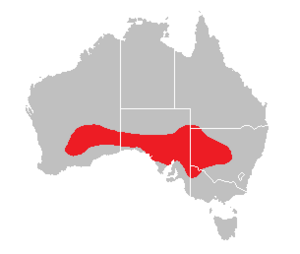Ctenophorus fordi facts for kids
Quick facts for kids Mallee dragon |
|
|---|---|
| Conservation status | |
| Scientific classification | |
| Genus: |
Ctenophorus
|
| Species: |
fordi
|
 |
|
| Distribution of Ctenophorus fordi | |
| Synonyms | |
|
|
The Ctenophorus fordi, commonly known as the Mallee dragon, is a type of lizard found in the dry parts of southern Australia. It's also called the Mallee military dragon or Mallee sand-dragon. This lizard was named after Dr. Julian Ralph Ford, a scientist who studied birds and reptiles. He collected the first Mallee Dragon specimens.
Contents
What Does the Mallee Dragon Look Like?
The Mallee Dragon is a small lizard. It grows to about 5 centimeters long, not counting its tail. It has a dark reddish-orange color. A pale stripe runs along its back, from its neck to its tail. This pale stripe has thin black lines next to it. The reddish-orange areas on its back often have small, pale spots.
Where Do Mallee Dragons Live?
You can find Mallee Dragons in dry areas of southern Western Australia and South Australia. Some populations also live in western Victoria and New South Wales. Australia's dry regions are home to many different kinds of lizards.
Mallee Dragon Life and Habits
Mallee Dragons live in sandy areas. Their homes include Mallee woodlands and areas with spinifex grass. They prefer places that haven't had fires for about 30 years. This allows the spinifex grass to grow thick, which they like.
Mallee Dragons wake up from their winter rest in August. Male dragons usually appear about four weeks before the females. They are active even on very hot days. They look for food in open, sandy spots. If they feel threatened, they quickly dash into nearby grasses or small bushes for safety. Male Mallee Dragons are known to be territorial.
When Mallee Dragons meet another lizard, they often "head bob." Both males and females do this. It's their way of communicating with each other.
What Do Mallee Dragons Eat?
The Mallee Dragon's diet mostly consists of ants.
How Do Mallee Dragons Reproduce?
Mallee Dragons reproduce by laying eggs. Mating happens in the spring. Female dragons lay several groups of eggs during the breeding season. Each group usually has two to five eggs. The baby dragons hatch from December to March. Male Mallee Dragons are not territorial when it comes to mating. There is no evidence of males fighting each other.
Protecting the Mallee Dragon
The Mallee Dragon is not currently listed as a species of major concern. This is according to the International Union for Conservation of Nature (IUCN).
The Mallee Dragon is protected in several national parks. These include the Mallee Cliffs National Park and Yathong Nature Reserve in New South Wales. It's also found in Currawinya National Park in Queensland. And you can find them in Murray-Sunset National Park in Victoria.
Threats to Mallee Dragons
Mallee Dragons face several dangers. These include:
- Loss of their homes due to land clearing.
- Damage to their habitat by animals like cattle and rabbits.
- Changes to their environment caused by climate change.
- Being hit by cars on roads.
- Wild predators like dogs, cats, pigs, and foxes.
- Dangers from introduced species like the cane toad.
- Threats from new diseases.


